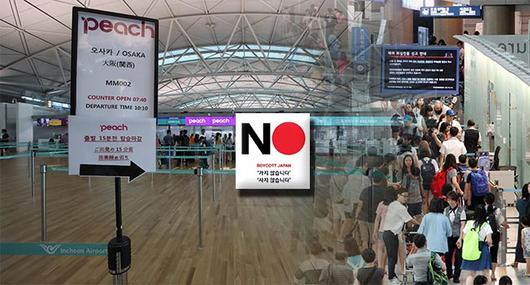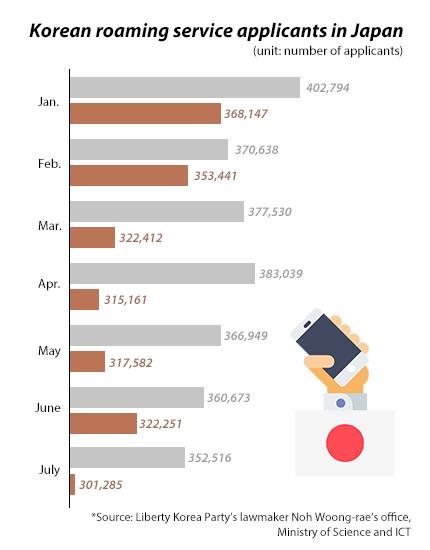 |
<이미지를 클릭하시면 크게 보실 수 있습니다> |
In another data to back reduced business and pleasure trips to Japan by Koreans, roaming mobile services for Korean nationals in Japan fell sharply in July.
According to data obtained by ruling Liberty Korea Party’s lawmaker Noh Woong-rae from the Ministry of Science and ICT on Monday, applicants for roaming service in Japan among subscribers of the country’s three leading mobile carriers – SK Telecom, KT and LG Uplus – reached 301,285 in July, down 7.9 percent from a month ago and 14.5 percent from a year earlier.
Cumulative service users from January to July also slid 11.6 percent to 2,310,279 from the previous year.
The data reflects the sharp decline in Korean travels to the neighbor country after Japan touched a raw nerve among Koreans who still bear bitterness towards Japan for its invasion and colonial rule by invoking trade embargo over past issues from July.
Those who already reserved travel products before the row also have chosen to cancel the reservation or reduce their stay period, making the consumer boycott against Japanese brands and travel to the country stretch on, according to market experts.
 |
As part of the ongoing boycott, imports of Japanese beer to Korea nearly halved in the previous month. Sales of Japanese beer at CU convenient store chains in Korea plunged 89.6 percent on year on Aug. 1-18, whereas domestic beer sales at the chain were up 16.3 percent during the period.
Beer imported other than Japan also saw a 19.7 percent increase in combined sales, showing a stark contrast to last year when Japanese brands took up more than 30 percent of all imported beer sales at CU outlets.
Another major convenience store chain GS25 also reported a sharp fall in Japanese beer sales during the period, taking up a mere 1.8 percent of the total sales of all brands. Last year, the stores sold 22.1 percent, or more than a third of imported beer, with those from Japan.
[ⓒ Maeil Business Newspaper & mk.co.kr, All rights reserved]
이 기사의 카테고리는 언론사의 분류를 따릅니다.
기사가 속한 카테고리는 언론사가 분류합니다.
언론사는 한 기사를 두 개 이상의 카테고리로 분류할 수 있습니다.
언론사는 한 기사를 두 개 이상의 카테고리로 분류할 수 있습니다.


